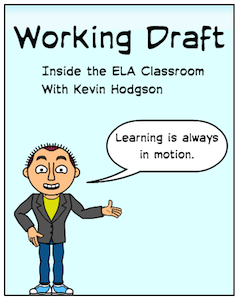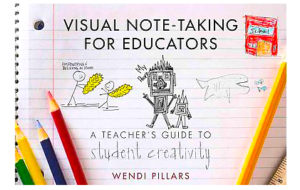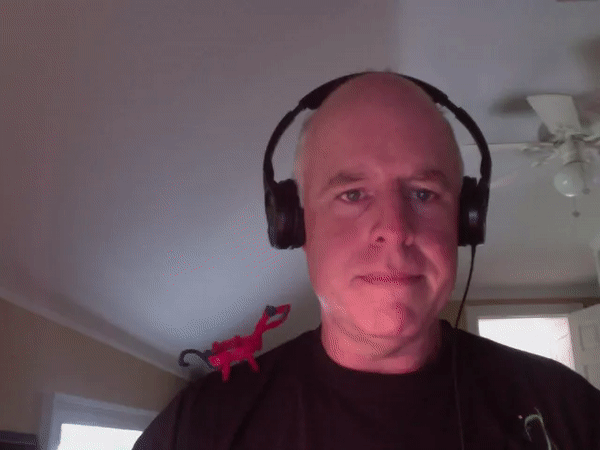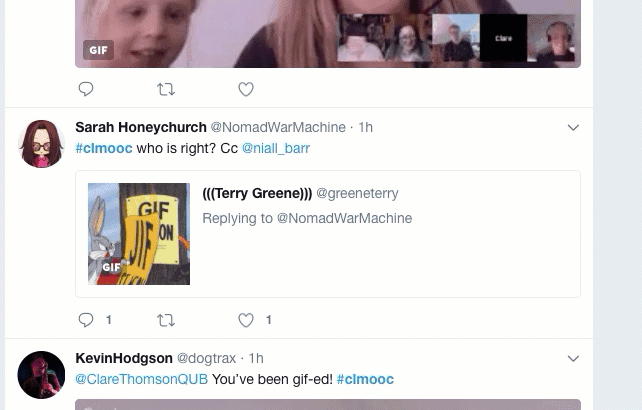
My first column for the year at Middleweb is about a sort of compare/contrast between two different professional development activities I engaged in this past summer.
One was CLMOOC. The other, wasn’t. ‘Nuff said.
Peace (framed),
Kevin

My first column for the year at Middleweb is about a sort of compare/contrast between two different professional development activities I engaged in this past summer.
One was CLMOOC. The other, wasn’t. ‘Nuff said.
Peace (framed),
Kevin
One of my goals for my sixth grade students this year is to learn how to do visual notetaking, or sketchnoting. When I asked each class of students how many doodled in the margins of notes, many hands went up. When I asked how many doodled to help remember what the teacher was saying or doodled as they were listening to a video or as they were reading a text to capture main ideas, very few hands stayed up.
We’re gonna bring those doodles into the main frame this year (and hopefully, not suck all of the fun out of drawing for them.)
I’ve started rather slow and simple. I traditionally begin the year reading Rudyard Kipling’s Rikki Tikki Tavi as my touchstone text for the year. It’s a story I will return to again and again as a common experience, and we work the story through discussions of protagonist, antagonist, conflict/resolution, foreshadowing and setting early and often.
This year, I had them sketchnote as they listened to me read aloud the story. (I did a small bit of this last year, around the presidential inauguration address.) I shared a video that gives a good overview of what sketchnoting is, and told them not to be intimidated by the young person’s amazing art, and then set them free to doodle as they did active listening.
Each day, after reading, I have shared my own sketchnotes with them (see the embedded images, which captured my drawings on the interactive board) and then talked my way through how the sketches help me remember characters and story. I also want them to show them that you don’t need to be a great artist to do this kind of work. You just need to have a library of shortcuts and a logical systems approach (my system moves from left to right, and then right to left, with arrows to help move me along in the reading).
That’s what this is all about: active listening. And it is what this particular class of students needs, given what I know about them in the past year and what I am already seeing. I am hoping the art element draws in more of them as learners.
I realize I have some questions yet to tackle when it comes to using this sketchnoting concept with them:
These will all be on my mind as I move forward into the school year. If you have experience or advice, I am all ears. This concept got a real boost this summer with my CLMOOC experience, as we used the theme of art to explore visual notetaking in ways that inspired me to begin early, and often, with my students.
I also have used this book — Visual Note-taking for Educators — by Wendy Pillars to think about this whole concept, and now that I have started with students, I need to go back and re-read some of her helpful suggestions and ideas.

Peace (drawn in ink),
Kevin
Way back in early summer, the first Make Cycle of the Connected Learning MOOC (CLMOOC) was centered on coloring and art. Since CLMOOC is all about collaboration and creativity, the folks facilitating the Make Cycle (led by Algot R.) decided on creating a collaborative coloring book.
We used Google Slides to gather coloring pages from all over the world. But Algot also wanted to turn the collaboration into a publishing opportunity — to create a physical book that teachers could use in the classroom as either art prompts or as an example of how collaborative ideas could turn into publishable works of art.
And so … here is our CLMOOC Collaborative Coloring Book, available now for order from Lulu Publishing. Lulu is a self-publishing site, and the process is relatively simple: you create a PDF of your work, choose the style of book you want, design the cover, and Lulu does the rest of the work in setting up the storefront.
Our coloring book costs less than $3 for about 50 coloring pages. Shipping is another $3 or so in the US (not sure about in other places around the world). No one is making any profit off this venture, although I wish there was an easy way to add to the cost of the book to act as a fundraiser for Hurricane Harvey recovery.
If you would rather just have a free PDF of the book and the cover, you are welcome to do that by downloading (just click on links).
Thanks to all who donated drawings and artwork, and thank you to the entire CLMOOC community for always inspiring others in the community to do art, be creative, find connections and nurture an online community spread out across all sorts of networks.
Peace (color it rainbow),
Kevin
A collaborative writing project that began in early summer in the Connected Learning MOOC has just wrapped up, and it was a blast, as a bunch of us engaged in some story writing with an invented character Miss Direction. It all began when our CLMOOC friend, Jeannie, remembered a hacked toy from the first year of CLMOOC that she had mailed around to folks for Vine stories.
Chalkboard Man disappeared that year, never to be seen again.
This year, we used another invented character from Jeannie’s imagination — Miss Direction — and made her out of paper. More than a 16 people from all over the globe downloaded a copy of Miss Direction, took her on an adventure to find Chalkboard Man, and then wrote about it (and documented with images or video) on a shared but secret Padlet space.
I created this as a teaser for the book release:
I have been wanting to do more with iBooks Author, the app on my Mac for publishing, so I took all of the text from the collaboration and created this downloadable book. Each chapter is another writer who hosted Miss Direction. As a bonus, each writer, after finishing their section, was encouraged to mail their version of Miss Direction to the next writer, so she flew through the mail quite a bit in different disguises.
Read and Download The Adventures of Miss Direction: Searching for Chalkboard Man via Scribd.
Or you can read it here, via this embed.
The Adventures of Miss Direction: Searching for Chalkboard Man by KevinHodgson on Scribd
I am also going to work through how to publish this as an eBook in iTunes as a free story. More later when I figure that out.
I love this kind of collaboration that unfolds over time. It’s a bit tricky to do the logistics on this kind of project, particularly where you want the story to remain hidden until the end.
Feel free to download your own version of Miss Direction. Color her and send her off on an adventure. Be sure to share, too.
Peace (there are clues),
Kevin

In the final Make Cycle newsletter of Connected Learning MOOC this week, we provided a list of ways members of CLMOOC can stay connected throughout the year. That includes you (CLMOOC is always an open experience and is now facilitated by participants).
Some suggestions for further connections:
Peace (let’s make it happen),
Kevin
I’m tinkering around with a visual typography app that Terry and Wendy shared out called TypiVideo. I like the effects of the moving text but I am having trouble with finding the ways that I can set animation and text (I know the controls are there, and I saw a tutorial that indicated where and how I can do more, but I can’t seem to have get to them to work on mine. Might need to reload the app.)
Anyway, the poem above is for another poetry venture elsewhere.
Peace (animated),
Kevin
There’s a cool, strange project going on with some musical collaborators (Wendy, Karon, Sarah, etc.) that uses the concept of “fractals” as a way to build a musical “round” with a common melody that comes from some data points within the Connected Learning MOOC (CLMOOC) community.
Fractal refers to the mathematical concept of patterns, often mirrored and expanding patterns, emerging from a set of data points, but can be mapped visually. Fractals often emerge in nature, which is pretty intriguing. Or, that’s my understanding of it.
See an example of animation of fractals:
The CLMOOC musical compositional activity — being done in Soundtrap so we can collaborate online — stemmed from some sharing of fractal animations last week. We were chatting about how animation might be used for learning, and better understanding of complex subjects.
Someone suggested the link between the mathematical underpinning of fractals and the weaving melodic possibilities of music … and we were off on another collaboration …
I took a small section of the larger piece of music underway and then utilized a neat animation interactive I found online to create a fractal, and then used iMovie to pull the emerging audio fractal (or a slice of it) with the animation. I think it came out pretty cool. Sort of a fractal teaser.
Peace (mirrored and shared),
Kevin
As we worked on animation and GIFs this week in CLMOOC, I was making comics as a “flat response” to the whole topic. Why? For fun.
Peace (and funny bones),
Kevin
I realized that my website resource for making Stopmotion Movies had a bunch of dead links and dead videos, so I spent some time this week making sure links worked and that old resources were replaced with new ones, etc.
Check out the Making Stopmotion Movies site. Use it and share it as you like.
As I note on the homepage …
Making movies encourages:
* Project-based learning
* Creativity
* Collaboration
* Story development skills
* Character development skills
* Presentation/Publication experience
* Technology expertise
And here are some links within the site:
We’re exploring animation and gif creation in CLMOOC this week. Come join us for a Twitter Chat today at 1 p.m. EST with the #clmooc hashtag.
Peace (beyond the camera click),
Kevin

We had a rich discussion yesterday at the Make with Me Hangout for Connected Learning MOOC (CLMOOC) on the issue of animation and gifs, exploring the notions of learning, explaining and pop culture integration with video loops.
Since it was a Make with Me, I worked on shooting this short stopmotion piece in the midst of the session, using a Google Chrome add-on app called StopMotion Animator (which I learned about via Richard Byrne’s Free Tech for Teachers). I had made my little creature with WikiStix and then converted my video file (from the app) into a gif with an online conversion site.
Here is the full Make with Me, with Sarah, Niall, Terry E., Terry G. and Clare.
Later, I used another Chrome add-one to make gifs of each participant for sharing on Twitter, which Sheri apparently pulled into one larger gif.

The question we were considering, why gif and why animation? played out a few ways as Sarah led us in discussion. Niall talked about how using animations in science classes allows for a visual way to teach complex topics (and allowing students to make animations of a science concept would demonstrate learning).
Clare talked about using animation with Lego Avatars with medical students, as an alternative way to spark discussion about reflection of practice. Terry G. and Terry E. both talked about the aspects of fun and being creative with various tools, using short video to make a point or to tap into pop culture. I shared how often I find myself, and my students, “breaking” the technology in order to make it do things it was not necessarily designed to do.
And there’s more in there …
We have a Twitter Chat planned for tomorrow (Thurs) on animation and gifs, so come join the conversation with the #clmooc hashtag. It all starts at 1 p.m. EST
Peace (in forward motion),
Kevin